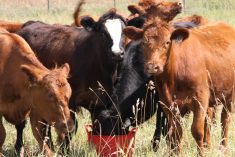OLDS, Alta. – One of Alberta’s largest cattle producers is taking a closer look at new research that shows some cattle eat less than others for the same amount of gain.
For Weldon Thomson, manager of Deseret Ranches in southern Alberta, the estimated $10 per head savings each year from more efficient cattle translates into $65,000 a year in savings.
“It’s significant. If we can gain $10 we’re looking for it,” Thomson told a group of producers and industry officials during a Tools for Building Better Cows conference.
Read Also

Animal protection delivery to change in Saskatchewan
The Saskatchewan government is looking for a new agency to handle animal welfare after Animal Protection Services of Saskatchewan decided not to renew its contract next year.
For the past two years Thomson has placed 40 of the ranch’s 300 yearling bulls into the net feed efficiency trials at Olds College in Olds, Alta.
The idea that some animals need less feed to gain the same amount as other animals is not new. Using a combination of radio frequency ear tags, feed bunk scales and computer equipment, researchers can tell exactly how much each animal weighs and gains.
John Basarab, senior beef research scientist with Alberta Agriculture, said the feed trials clearly showed some animals have better net feed efficiency, which is also called residual feed intake.
Like a golf score, positive is not good. The most efficient animals have a negative NFE.
Basarab and his team discovered that inefficient animals created more manure and methane and ate more than they should for their body size and growth.
“These inefficient animals are not retaining as much in feed energy in muscles and fat,” he said.
An inefficient animal expels 182 litres of methane a year while an efficient animal expels 136 litres.
“That’s 25 percent lower, that’s huge,” said Basarab, who believes cattle producers could reduce their feed bill by selecting for efficient cattle and also gain valuable greenhouse gas credits by reducing the amount of methane that cattle produce.
“We reduce methane, but more important we reduce feed costs,” he said.
The economic potential after seven to 10 years of selection for NFE is estimated to be $109 million annually for Alberta’s feeder cattle industry and at least as much for cow-calf producers, he added.
While the research is still in its infancy, Thomson believes real savings can be made in both his 6,500 head cow operation and 3,500 head yearling operation.
“Right now we’re just hoping it’s going to make a difference.”
Randy Kaiser of Ponoka, Alta., has also tested his bulls for net feed efficiency. Like Thomson, he doesn’t know if he’s seen feed savings yet, but he sees it as one more tool that can help cut feed costs.
“I can only speculate on its potential,” said Kaiser, who raises Welsh Black and Galloway cattle. “That opportunity doesn’t come along every day.”














